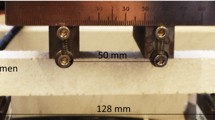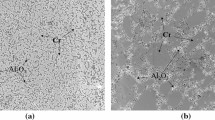Abstract
In this work, strength properties of porous alumina with three different porosities as well as dense one were investigated to clarify porosity effects on strength properties. It was revealed that the strength had a general tendency to decrease drastically as increasing porosity. Spatial and size distributions of pores were characterized by observing specimen surfaces through a laser scanning microscope. Based on the observed pore characteristics, a procedure to estimate porosity effects on strength was newly developed in the framework of fracture mechanics, where a stress intensity factor-based criterion was applied for fracture of porous ceramics. In the procedure, it is assumed that porous ceramics have the same characteristics of crack distribution as those of pore distribution, and pores are presumed to be surrounded by virtual cracks. Monte Carlo simulations by using the procedure were carried out to estimate strength for four respective materials. Simulated strength coincided with experimentally observed one within a scatter band of factor of 21/2. Consequently, the developed procedure was confirmed to be efficient in evaluating effects of bulk porosity and pore distributions on strength of porous alumina.
















Similar content being viewed by others
References
R. Eugene, Compression Strength of Porous Sintered Alumina and Zirconia, J. Am. Ceram. Soc., 1953, 36(2), p 65–68
T. Hoshide, T. Fukui, and T. Yamada, Effect of Porosity on Strength of Zirconia Refractory, Soc. Mater. Sci. Jpn, 1988, 37(421), p 1139–1145
C. Kawai and A. Yamakawa, Effect of Porosity and Microstructure on the Strength of Si3N4: Designed Microstructure for High Strength, High Thermal Shock Resistance, and Facile Machining, J. Am. Ceram. Soc., 1997, 80(10), p 2705–2708
K. Yoshida, H. Tsukidate, A. Murakami, and H. Miyata, Influence of Pore Size on Fracture Strength of Porous Ceramics. J. Solid Mech. Mater. Eng., 2006, 72(722), p 1511–1517
T. Fujii, Y. Akiniwa, and T. Amata, Brittle Fracture Analysis of Porous Ceramics Based on Initiation of Micro Damages, J. Soc. Mater. Sci., Jpn, 2007, 56(3), p 244–251
Testing Method for Flexural Strength (Modulus of Rupture) of Fine Ceramics at Room Temperature, JIS R 1601. Japanese Industrial Standard, Japanese Standards Association, 2008
W. Weibull, A Statistical Theory of the Strength of Materials. Ingeniors Vetenskaps Akademiens, Handlingar Nr 151, 1939.
M.F. Ashby and D.R.H. Jones, Engineering Materials—An Introduction to Their Properties and Applications, Pergamon Press, Oxford, 1980, p 81
T. Hoshide, Interrelation analyses of mechanical properties in commercial ceramics using cataloged data, Mater. Sci. Res. Int., 1998, 4(3), p 179–185
T. Hoshide and T. Inoue, Simulation of Anomalous Behavior of a Small Flaw in Strength of Engineering Ceramics, Eng. Fract. Mech., 1991, 38, p 307–312
T. Hoshide, H. Furuya, Y. Nagase, and T. Yamada, Fracture Mechanics Approach to Evaluation of Strength in Sintered Silicon Nitride, Int. J. Fract., 1984, 26, p 229–239
T. Hoshide, Grain Fracture Model and its Application to Strength Evaluation in Engineering Ceramics, Eng. Fract. Mech., 1993, 44, p 403–408
T. Hoshide and M. Masuda, Dependence of Strength On size of Flaw Dominating Fracture in Ceramics, Mater. Sci. Res. Int., 1995, 1, p 108–113
Y. Murakami, A. Aoki, N. Hasebe, Y. Itoh, H. Miyata, N. Miyazaki et al., Stress Intensity Factors Handbook, Vol 1&2, Pergamon Press, Oxford, 1987
Y. Murakami, M.T. Hanson, N. Hasebe, Y. Itoh, K. Kishimoto, H. Miyata et al., Stress Intensity Factors Handbook Vol 3: The Society of Materials Science, Japan, Pergamon Press, Oxford, 1992
Y. Murakami, N. Hasebe, Y. Itoh, K. Kishimoto, H. Miyata, N. Miyazaki et al., Stress Intensity Factors Handbook Vol 4&5: The Society of Materials Science, Japan, Elsevier Science, New York City, 2001
T. Hoshide and H. Sugiyama, Numerical Analysis of Sample-Size Effect on Strength of Alumina, J. Mater. Eng. Perform., 2013, 22(1), p 1–8
Acknowledgments
The authors thank Mr. Nakamura for his help in experiments.
Author information
Authors and Affiliations
Corresponding author
Rights and permissions
About this article
Cite this article
Miyazaki, N., Hoshide, T. Influence of Porosity and Pore Distributions on Strength Properties of Porous Alumina. J. of Materi Eng and Perform 27, 4345–4354 (2018). https://doi.org/10.1007/s11665-018-3500-x
Received:
Revised:
Published:
Issue Date:
DOI: https://doi.org/10.1007/s11665-018-3500-x




